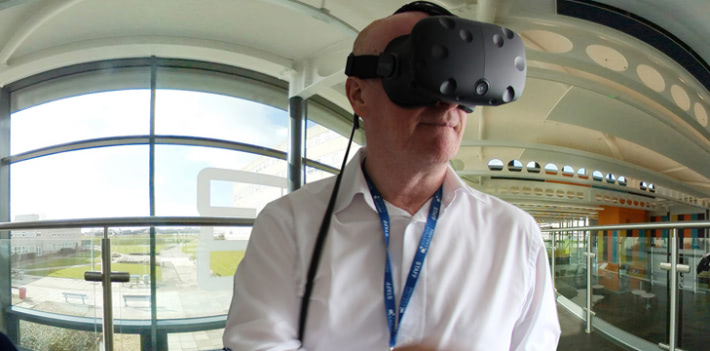Preston’s College shares their top ten tips for augmented and virtual reality #FutureofEducation

Preston’s College’s e-learning team wanted to explore the potential of virtual reality (VR) and augmented reality (AR) technology for learning and teaching but was put off by the cost of the equipment and inflexibility of the resources on display at edtech shows in London.
Jisc’s AR and VR specialist, Matt Ramirez, helped the team to see how they could use low-cost, consumer-end scanners and cameras to achieve their goals, bringing resources to life in nearly every department across the college.
The college is now using AR and VR in a wide range of ways, making innovative technology much more accessible to learners.
Preston’s College top ten tips
E-learning developer, Frank McHale, and learning outside the classroom project manager, Steve Smith, tell us their top ten tips for AR and VR on a virtual budget:
1. Invest in R&D
As a college, give your e-learning developers the freedom to do some research and development work and see what they come up with. Don’t be scared to fail. Some things won’t work but you don’t have to spend a lot of money on it in the early days.
2. Start small
What we learnt very quickly – thanks to Jisc – is that entry level technology can still be very good.
While we found limitations with our first 360 camera, it only cost us £200 and it enabled us to prove what we were able to achieve. As a result, the college felt confident investing in a £400 camera.
Buy at entry level and just get going. It’s been a complete eye opener how much we can get out of really low cost tech.
3. Have a plan
Have a strategy for how the technology could make a difference across your college, not just in one corner.
We knew that AR would get taken up by the IT school, but we wanted to show that it could be used in a range of different departments, from auto mechanics to dance.
4. Skill up
One of the benefits of consumer-level equipment is that YouTube is full of how-to videos and you can skill yourself up pretty quickly. We felt that AR and VR was really new ground for us but it turned out to be much easier and more fun to use the kit than we had expected.
5. Don’t talk, do
Tutors need to see a purpose and use for any new technology and to understand how it can benefit them and their learners. Find a willing teacher or department and get a quick example up and running.
We 3D-scanned a plastic model of a hair follicle we came across in a biology lab, put it onto a platform using free online software and then embedded it in the college VLE.
We expected the biology department to find it useful – but so did tutors from hair and beauty and motor engineering once they saw it!
6. Go walkabout
Get out and about around your college and see what teachers are dealing with in their own environments.
From day one of getting the equipment we went into different classrooms, studios and garages, scanning and filming things. You only have to stand there for five minutes using a strange bit of equipment and you get the attention of both tutors and learners.
7. Showcase
On inset and CPD days put on a showcase to demonstrate how technologies are being used in different departments.
Have a light touch, hands-on CPD session and ask for suggestions for projects.
8. Consolidate
It’s all very well making cool stuff and getting excited about it but when it comes down to it, how does this help formative assessment?
We use our VLE to host streaming video so that learners such as dancers or auto engineers can, for example, watch a 360 video of a workshop on their smartphone, embed information into it to show that they understand particular aspects and then be assessed on it.
All the time think about how the use of the technology can be consolidated so it can be demonstrated that it improves student chances and experience.
9. Look ahead
Keep an eye on AR and VR developments – it is such a fast growing area and new opportunities or better ways of creating content are appearing all the time.
10. Talk to Jisc and network with your peers
If we hadn’t asked Jisc for help and been to see Matt Ramirez we may have gone down the wrong path and invested in something that was never going to give us the return we needed.
It saved us making an expensive mistake.
Find out what other colleges are doing, too, and, again, Jisc can point you in the direction of innovative work and interesting people.











Responses